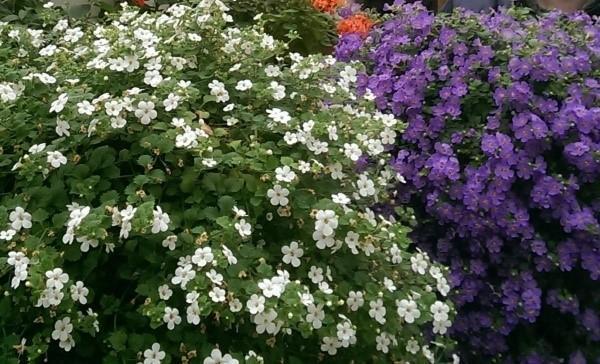We study the cultivation of bacopa - an elegant and unpretentious flowering perennial for the garden, home and aquarium
 Lush bakopa bushes with an elegant flowering cap have long been appreciated by gardeners and florists. Despite its tropical nature, it is one of the most unpretentious plants, and many are interested in growing bacopa. Well, how to get past the dense curtains with long curly shoots, decorated with small foliage and large inflorescences? Due to its beautiful decorative appearance, Bacopa is widely used both in the open field and as a pot culture, as well as for breeding in aquariums. Be sure to try to grow this culture, and today we will tell you how to do it.
Lush bakopa bushes with an elegant flowering cap have long been appreciated by gardeners and florists. Despite its tropical nature, it is one of the most unpretentious plants, and many are interested in growing bacopa. Well, how to get past the dense curtains with long curly shoots, decorated with small foliage and large inflorescences? Due to its beautiful decorative appearance, Bacopa is widely used both in the open field and as a pot culture, as well as for breeding in aquariums. Be sure to try to grow this culture, and today we will tell you how to do it.
Features of planting bacopa
If you do not have the opportunity to purchase young plants or to get hold of cuttings, you will have to buy seeds. This is not the easiest, but more affordable way to breed bacopa. The main challenge in seed growing is seed size. They are very small, which requires a special approach. It is necessary to sow bacopa only in loose soil, while the sowing should be superficial. If you bury and "bury" the seeds, they simply won't sprout.
For sowing, find shallow containers, fill them with a light medium, and slightly moisten the soil. Then spread the seeds evenly over the surface of the soil. You don't need to put them on top. Just spray the crops liberally with a spray bottle. The water will be absorbed and slightly deepen the planting material. It would be enough. It remains only to close the lid and put the container in a warm place. The optimum temperature for seed germination is from 20 ° to 25 ° C.
In the "greenhouse" period, subject to the presence of a cover or film, crops can not be watered. But it is necessary to ventilate twice a day. After about 2-3 weeks, the first shoots will appear. Now the cover can be removed and the seedlings can be transferred to a cooler room.
Growing bacopa should take place in a cool place with a temperature of no more than 18 ° C. If it is hot in the room, the seedlings will begin to stretch, and besides, they will not be able to form a developed root system.
Growing Bacopa - How to Care for a Plant and What It Loves
When your seedlings reach 5 cm, dive the plants into a separate growing container. Small plastic cups will do. In them, Bacopa will build up both the aboveground and root parts. Water the seedlings in time - the flower loves moisture.
To stimulate the growth of additional roots, periodically give the young bacope a “drought”. If the soil is moist all the time, despite the love of moisture, the plant will drive the deciduous mass. In this case, the roots will be small. Over time, they simply will not be able to provide such a green hat with food.
Further care for bacopa includes the following activities:
- Timely watering (taking into account these recommendations at the stage of growing seedlings).
- Formation. Bacopa branches well on its own, but not evenly. As soon as the shoots on the bush begin to stretch in different directions and get out of the general shape of the "cap", cut them off. The resulting cuttings can be used for propagation of the culture by rooting them. Do not spare, and do not leave too long shoots. They will spoil the appearance of the bush and deprive other branches of food. And after pruning, the lateral buds will wake up, and the bush will become lush.
- Transplant. When the root system fills the cup completely and is visible through the root walls, transfer the bacopa to a pot or permanent place in the garden.
When growing Bacopa outdoors, keep in mind that it likes good lighting, but not direct light. Fresh air is good for the plant, but it will not survive the frost. Water the bushes regularly, keeping the soil dry so they don't wither.
And one more nuance: Bacopa should winter indoors, otherwise it will freeze out. Before frost, dig up the plants and plant them in pots, cutting off the aboveground part. Leave the bacopa in a cool place until spring, watering only occasionally.